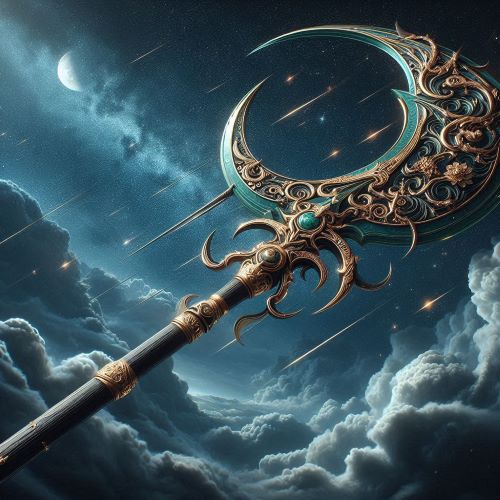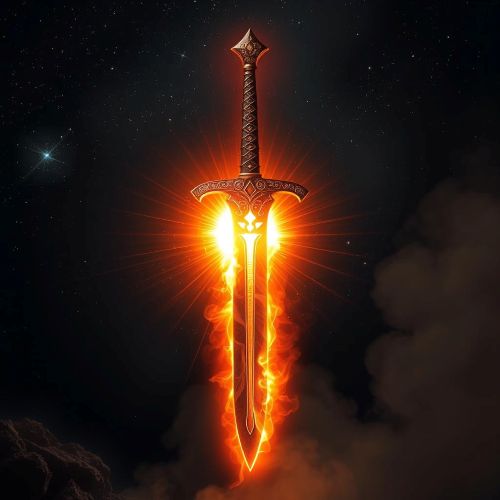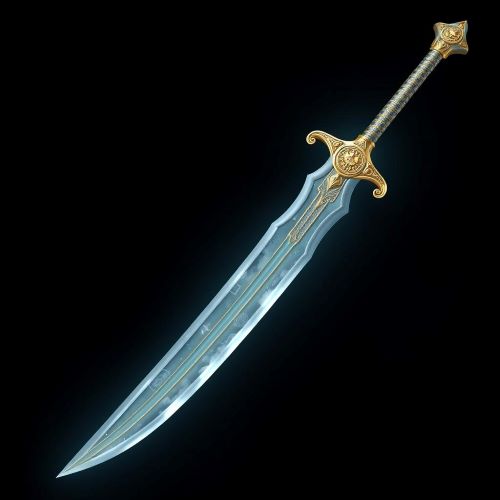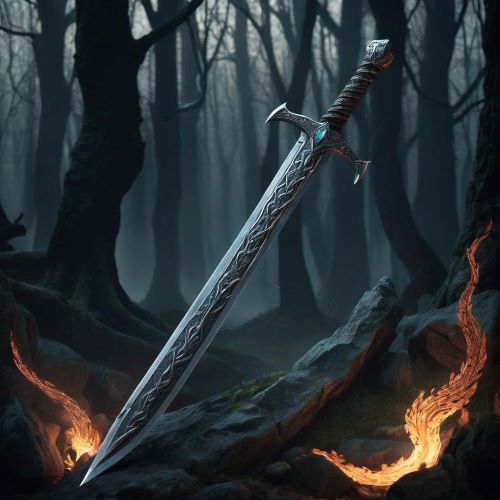Chrysaor : The Golden Blade
Chrysaor
Introduction
In the vast and intricate world of Greek mythology, many names evoke the grandeur of gods and the heroics of mortals, yet some figures remain shrouded in a mystique that transcends direct storytelling. Chrysaor is one such presence. His very name means “Golden Sword” in Greek, a title that blurs the line between weapon and warrior. Emerging from one of the most striking moments in ancient myth—the slaying of Medusa—Chrysaor’s story combines divine parentage, violent birth, and symbolic power. While his appearances in surviving myths are scarce, his image as a golden-hued figure of martial authority endures, casting him as an emblem of both creation from destruction and the immortal weight of divine weaponry.
Origins
Chrysaor’s birth is one of the most dramatic and visually potent episodes in Greek myth. When Perseus beheaded Medusa, two beings leapt from her blood: the winged horse Pegasus and Chrysaor. This sudden emergence, described in Hesiod’s Theogony, bypasses the natural stages of life, presenting him as a fully formed figure tied to both terror and wonder. His father is identified as Poseidon, god of the sea, who had once lain with Medusa before she became a Gorgon. This heritage merges the divine realm of Olympus with the monstrous depths of the underworld.
Unlike his brother Pegasus, whose adventures are well documented, Chrysaor’s path remains largely unchronicled. Ancient descriptions vary—sometimes he is depicted as a mighty warrior, sometimes as a giant, and occasionally in symbolic form as the embodiment of a weapon. The very fusion of “gold” and “blade” in his name suggests that his identity may have originated as a personification of a divine sword before evolving into a mythic figure in his own right.
Think you know your myths and legends? Dive into the world of ancient stories and test your knowledge with our engaging quizzes on Mythlok!
Powers
Although ancient texts do not dwell on detailed accounts of Chrysaor’s exploits, the attributes tied to his name are powerful enough to build his mythic presence. A golden sword in Greek tradition is not just a weapon—it is an emblem of purity, immortality, and divine favor. By virtue of his birth, Chrysaor inherits associations with transformation, as his life springs directly from death.
In later interpretations, he is imagined as a formidable combatant, his skill with the blade matched by the supernatural qualities of the weapon itself. As a son of Poseidon, he would likely share in his father’s dominion over the seas, granting him a vast battlefield and the ability to command maritime forces. Modern retellings lean into this potential, portraying him as both a master swordsman and a cunning tactician.
The symbolism of Chrysaor extends beyond battle prowess. His very existence represents the cycle of destruction and renewal, a recurring theme in Greek cosmology. The golden sword becomes a metaphor for divine justice—swift, decisive, and unyielding in the face of chaos.
Owners/Users
In the oldest myths, Chrysaor is inseparable from the weapon that defines him; he is its sole and eternal bearer. Yet the title “golden-sworded” or “golden-bladed” appears in Greek literature as an epithet for other deities, hinting that the symbolic power of Chrysaor’s name transcended his own limited mythic role.
Demeter, in certain poetic works, is referred to as “Chrysaor” in connection with her curved golden sickle, a tool tied to harvest and retribution. Apollo is also given this epithet in Homeric hymns, reinforcing its association with divine authority. In the Carian city of Stratoniceia, a cult worshipped “Zeus Chrysaoreus,” linking the name to rulership and heavenly might.
Later literature expands this tradition into new contexts. In Edmund Spenser’s The Faerie Queene, the sword Chrysaor is bestowed upon Sir Artegall, the Knight of Justice, by the goddess Astraea. Here, the weapon is reimagined as a mortal heirloom of divine justice, preserving its mythic weight while shifting it into the realm of medieval allegory.
Instances used
In ancient sources, Chrysaor’s personal adventures are minimal, yet his genealogical role connects him to one of the great labors of Heracles. With the Oceanid Callirrhoë, Chrysaor fathers Geryon, the three-bodied giant whose cattle Heracles must steal. This link situates Chrysaor at a crucial point in the heroic cycle, even if he remains offstage in the narrative.
His most vivid mythic moment remains his birth—a scene rich in visual symbolism and cosmic significance. From the lifeless body of Medusa springs not only a creature of beauty and grace, Pegasus, but also a golden warrior whose mere presence suggests destiny and divine design.
In modern adaptations, authors have given Chrysaor the active role that ancient myths left vacant. Rick Riordan’s The Mark of Athena transforms him into a pirate lord commanding dolphin warriors, clad in a golden Gorgon mask, and wielding his famed golden blade—renamed “Imperial Gold” by Roman demigods. His duels with Percy Jackson showcase both his mastery of the sword and his strategic cunning, turning him into a formidable antagonist.
These reinterpretations not only bring Chrysaor into the spotlight but also underscore his enduring appeal as a symbol of forgotten power, waiting to be rediscovered.
Frequently Asked Questions
Lorem ipsum dolor sit amet, consectetur adipiscing?
Lorem ipsum dolor sit amet, consectetur adipiscing elit. Praesent convallis vestibulum justo, ac tincidunt nunc vehicula quis. Nullam id dolor quis orci malesuada feugiat. Curabitur aliquet libero at urna ullamcorper, ac ultricies nulla dapibus.
Lorem ipsum dolor sit amet, consectetur adipiscing?
Lorem ipsum dolor sit amet, consectetur adipiscing elit. Praesent convallis vestibulum justo, ac tincidunt nunc vehicula quis. Nullam id dolor quis orci malesuada feugiat. Curabitur aliquet libero at urna ullamcorper, ac ultricies nulla dapibus.
Lorem ipsum dolor sit amet, consectetur adipiscing?
Lorem ipsum dolor sit amet, consectetur adipiscing elit. Praesent convallis vestibulum justo, ac tincidunt nunc vehicula quis. Nullam id dolor quis orci malesuada feugiat. Curabitur aliquet libero at urna ullamcorper, ac ultricies nulla dapibus.
Lorem ipsum dolor sit amet, consectetur adipiscing?
Lorem ipsum dolor sit amet, consectetur adipiscing elit. Praesent convallis vestibulum justo, ac tincidunt nunc vehicula quis. Nullam id dolor quis orci malesuada feugiat. Curabitur aliquet libero at urna ullamcorper, ac ultricies nulla dapibus.
Lorem ipsum dolor sit amet, consectetur adipiscing?
Lorem ipsum dolor sit amet, consectetur adipiscing elit. Praesent convallis vestibulum justo, ac tincidunt nunc vehicula quis. Nullam id dolor quis orci malesuada feugiat. Curabitur aliquet libero at urna ullamcorper, ac ultricies nulla dapibus.
Watch
Source
Hesiod. (2006). Theogony and Works and Days (M. L. West, Trans.). Oxford University Press.
Graves, R. (2017). The Greek Myths. Penguin Classics.
Hard, R. (2004). The Routledge Handbook of Greek Mythology. Routledge.
Morford, M., Lenardon, R., & Sham, M. (2018). Classical Mythology (11th ed.). Oxford University Press.
Theoi Greek Mythology. (n.d.). Chrysaor. Retrieved August 15, 2025, from https://www.theoi.com/Pontios/Chrysaor.html
Perseus Digital Library. (n.d.). Hesiod, Theogony. Tufts University. Retrieved August 15, 2025, from http://www.perseus.tufts.edu/hopper/text?doc=Perseus%3Atext%3A1999.01.0130%3Acard%3D270
Mythopedia. (n.d.). Chrysaor. Retrieved August 15, 2025, from https://mythopedia.com/topics/chrysaor
World History Encyclopedia. (n.d.). Medusa. Retrieved August 15, 2025, from https://www.worldhistory.org/Medusa/
Greek Legends and Myths. (n.d.). Chrysaor – The Golden Warrior. Retrieved August 15, 2025, from https://www.greeklegendsandmyths.com/chrysaor.html









